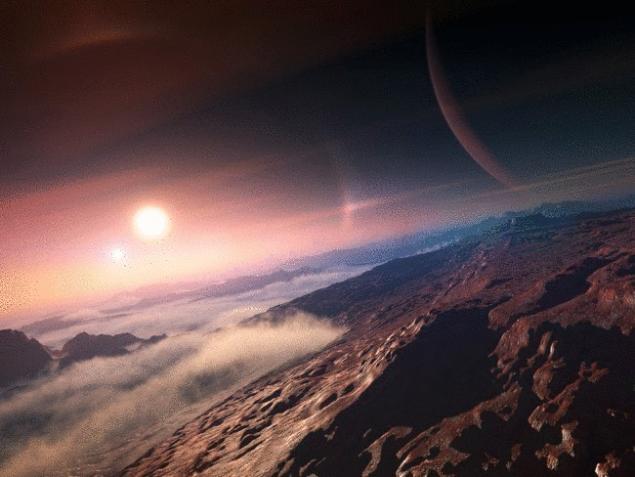696
Alien life will be easier to find, not where you think

Deep under the surface of Mars can nest tiny microbial life, she can splash in the underground oceans of Saturn's moon Enceladus, but these places are unlikely to be those where we find the first forms of life beyond Earth. The bad news is that the first extraterrestrial life mankind finds likely too far to be able to visit.
"I think we may be able to detect life on another planet in the next decade or so, says Christopher impey, an astronomer from the University of Arizona. We will be able to do it, "exploring exoplanets that we are opening in large numbers". Impey discussed it with other members of the American physical society at the April meeting on extraterrestrial intelligence.Exoplanets are planets that exist outside our Solar system. The nearest known exoplanets to date, revolves around our nearest star alpha Centauri B 4.3 light years from Earth, but with our current technology path it will take about 100,000 years.
Why exoplanets?To locate another life force beyond will be quite difficult, regardless of where to look for astronomers, but for exoplanets there are a number of serious advantages.
First, in our galaxy more earth-like exoplanets than in our Solar system. The earth is, in fact, is the only terrestrial planet in our neighborhood, it is Mars, but it is not all clear. Currently in our galaxy there are more than 45 of extrasolar planets deemed potentially habitable.
Another advantage is that the search for life on exoplanets more cheaply and effectively by using earthly tools, than to search them in our Solar system.
Large government institutions like NASA and the European space Agency will soon have to land robotic probes on the moon of Jupiter, Europe and other promising places in the Solar system to detect evidence of life. (The only exception may be water-rich moon of Saturn, Enceladus). At the moment the only mission to land on the solid ground plans of NASA is the Mars mission 2020, which will not even be able to "dig" deep enough to find signs of life. That's why the exoplanet in the background that look promising.
"These missions cost billions of dollars and take decades, and the NASA budget is so small that will only last for one mission at a time, says impey. — I think rather the goal to get a project to study the atmospheres of earth-like exoplanets".With powerful telescopes on Earth, scientists can sniff out alien life throughout the galaxy, studying different cocktails of gases in the atmospheres of these exoplanets. Only planet with a certain set of key elements and molecules have the potential to contain life.
The chemical recipe for life,of Course, all this is excluding the fact that scientists are still debating what should be the perfect cocktail.
For example, last year the discovery of oxygen — an important element of life on Earth — in the atmosphere of exoplanets perceived as emergency opening and immediately felt confident sign of the presence of life.
But in may 2014 a pair of scientists Robin Wordsworth and Raymond Pergament — suggested that universes with large amounts of liquid water can hold a lot of oxygen, but will be devoid of life. This is because the light from the star the planet may have enough energy to split atoms of hydrogen and oxygen that comprise the water vapor in the atmosphere, then the hydrogen will escape into space, leaving behind oxygen.
"Any hints on the remote detection of life outside our Solar system will attract the attention, says Jack O'malley-James. Thus, a good knowledge of non-biological sources of atmospheric gases, along with methods for identifying these sources will help make these hints more confident."However, it is unclear what chemical substances can indicate the presence of life. Impey believes that we should look for ozone (O3) and methane (CH4).
A new fleet of the giant of revolutionary telescopesWhile scientists like Wordsworth and Pieralberto investigate, where to search for life, astronomers and engineers working on the tools that we will use in the search for life outside our Solar system: build the largest and most powerful telescopes in history.
"Exoplanets are far away, and they are very dull, says impey. — You need a large surface to collect the light of earth-like planets at this distance".The surface of the telescope is determined by the size of the so-called mirror, which collects the light of distant objects. Astronomers study the light, revealing the different chemical signatures in the atmosphere. Just as each person has a unique fingerprint, each item has a certain light signature that astronomers determined using spectroscopy.
You will need a powerful telescope in history, to discover a dim light signatures of these molecules distant exoplanets. Now astronomers at institutions around the world build three huge telescope next generation: two in Chile and one in Hawaii.
The giant Magellan telescope (GMT) will be three times larger than any of the modern telescopes and will be able to produce images 10 times sharper than the Hubble space telescope. Currently he is in under construction at the Observatory of Las Campanas in La Serena, Chile, and is scheduled to open in 2024.
Thirty meters teleskom (TMT), expected to be able to produce images 12 times sharper than the Hubble space telescope and scheduled to work on top of an extinct Hawaiian volcano Mauna Kea in 2025. However, recent protests have slowed construction.
The European extremely large telescope (E-ELT) will have a mirror more than the GMT and TMT. The construction of E-ELT start in June 2014 in Cerro Armazones, Chile, and to work this colossal telescope will begin in 2024.
Three of these huge telescope can see distant worlds and, maybe, just maybe, will make the most important discovery in the history of mankind, and answer tantalizing our curious minds question: are we alone? published
Source: hi-news.ru
Story of friendship between a magpie and a homeless boy, which has 78,000 followers on Instagram
9 ways to believe in yourself























